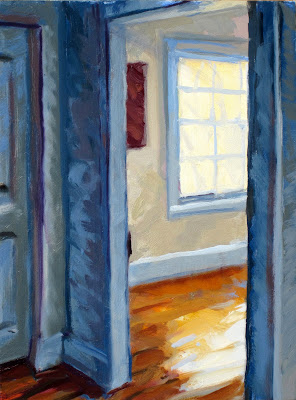The Tricky Balance of Contemporary Art
Philip Koch, Sun in an Empty Room III, oil on panel, 12 x 9", 2012
To anyone who tries to follow contemporary art I want to say I understand why you feel confused. If it's true that art holds a mirror up to life, isn't this pretty much to be expected? Almost everyone I know is glad to be here. But that said, they're bewildered by living much of the time.
"Contemporary Art" isn't a style. It just means art that has been made today. If used properly, the term extends all the way from performance art using digital video projections to work made by artists who think everything that happened after the 19th century French painter Ingres stinks.
I have two observations.
There has been an explosion in the number of possible ways artists can make art. A young student at my art school in Baltimore is expected to have at least familiarity with the following: digital art, video art. performance, installation, time based art, community engagement art, sound art, and then drawing, painting, and the rest of the traditional media. It's a little like asking a struggling juggler to add another half dozen balls in the air all at once- some can do it, but just as often the attempts come crashing down and go bouncing off on the floor in all directions.
My advice to young artists would be to give all these competing media a try to see which speaks to you. But don't continue barking up every tree in the forest. Eventually you have to narrow down the tasks and practice until you get really masterful at it. That's what people are coming to you to see.
The other extreme are the artists who fall under the spell of the art of the past. It is easy to fall in love with the amazing accomplishments of a Rembrandt. Though that artist's drawings are pushing 400 years old, they continue to blow me away with their uncanny ability to let you feel the artist's hand and his heart. What seems troublesome though are contemporary artists who do paintings of figures wading on sandy beaches wearing dresses that were highly stylish 100 years ago and haven't actually been seen in public since.
I always urge my students to learn from the best artists from art history but to be careful not to let oneself be taken over by the past. I make a joke about how they don't want to become practitioners of "Embalmed Realism."
Above is one of my oil paintings done just a few months ago. It's a painting where I'm taking my painter's eye (that was raised on color field painting and geometric abstractions) and using it to look back on the past- both my own and on art history. My painting was done on my portable French easel crammed into the narrow hallway on the second floor of the home Edward Hopper was born in (now the Edward Hopper House Art Center in Nyack, NY) I'm peering into the room where he slept every night more or less until he was 30 years old.
Hopper was sort of an alternative father figure for me. Once I'd seen the way he captured sunlight and sculpted his long moody cast shadows I was hooked. Abandoning my early direction as an abstractionist I resolved to charge down the realist path. But I do it with tools I brought with me from my abstract painting days- in particular a willingness to playfully invent color combinations that I haven't really seen but that I feel will best express the feeling tenor I'm after.
Inspired by the past grand gestural works of expressionist painters from Picasso to Arshile Gorky I learned I loved to play with the mark-making side of painting. An artist's brush moves over the surface on a painting and leaves a track just like an ice skater gliding through untouched ice. In my painting look at how the brushstrokes move diagonally uphill to the left in the dark blue foreground wall. Then I've pushed the opposite uphill-to-the-right direction in the far room's cream colored wall. I had to do this to make the viewer feel those walls contained an emptiness that mattered.
Hopper was a great example to me because of the way he struggled to absorb the best from his teacher, Robert Henri, without becoming just a follower of this teacher's broadly brushed style. Some of Hopper's most beautiful oils I believe are his extremely Henri-influenced impressionist street scenes of Paris. Hopper made them shortly after studying with the charismatic Henri. Slowly Hopper evolved in this painting towards a way of seeing that retained much of Henri's drama, but was thinner and more dry-looking in appearance. It took Hopper years to find his own vision because it wasn't just a matter of selecting a different philosophy of art. Rather his progress grew out of a years long trial-and-error search that is at the heart of all genuinely powerful art.
My painting above couldn't be more Hopper-centric in terms of where it was painted. But if you look closely in its paint surface and color choices it really doesn't look like Hopper. That's because my personality at its core is different than his. As I grow as a painter I move down a path that I am in the business of discovering. There's a wonderful saying by the Spanish poet Antonio Machado "Searcher there is no road. We make the road by walking."



